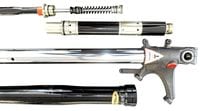Re: The Perfect Setup
In your suspension article "The Perfect Setup" (Dec./Jan. '16), you said that front sag "depends on what's inside your forks as far as springs and top-out springs," and that we shouldn't worry about it "unless a reputable suspension person gave you a number to aim for." Can you elaborate on that? How am I supposed to set preload if it's not to get a certain amount of sag? Why does this apply to the front suspension but not the rear? And how do the top-out springs affect sag?
Jesse Daniel
Palo Alto, CA
Top-out springs work against the main spring at the very top of the travel, and their original intent was to protect the fork or shock from topping out metal to metal with a hard stop. But over time these short, stiff springs have evolved into longer, softer springs, as they can change how the suspension works near full extension. For example, if your bike has no top-out springs in the fork, it can take 10 or 20 pounds of force (or more) to overcome the preload just to move the front suspension from fully extended. As you can imagine, small bumps do not work the fork at all when this is the case, and the tire will skip over these bumps under acceleration, causing a loss of compliance and traction. But with top-out springs, the fork action can be changed so that light loads and those small bumps do move the fork, making the suspension much more compliant during acceleration.
Because the top-out springs act to compress the suspension, they need to be taken into account when it comes to sag. For example, a fork with no top-out springs may need 30mm of sag to work properly; if we were to add a set of top-out springs with a length sufficient enough that they are partly compressed at the sag measurement, sag may need to be, say, 40mm if the fork is to work the same further down in the travel. The sag measurement is still very important and goes a long way to determining how the suspension works, as it in part defines the working range of the fork. But because there is such a variety of top-out springs being used, it’s difficult to give a general number for sag that will apply to the majority of bikes. This is how a suspension expert, who knows what’s inside your fork, can determine a sag number that will work with your setup.
Few stock shocks have top-out springs, but most aftermarket shocks do; just as with the fork, top-out springs in the shock allow the suspension to track over small bumps at the top of the travel, such as under heavy braking. Typically, shock top-out springs are short enough that they are at their full length and out of the equation at the sag measurement. As a result, we can still use 25 to 30mm sag as a good starting point for most bikes.
Without a sag number to use as a baseline for the front suspension, you can adjust preload based on how it affects front ride height and geometry because that is mostly what you are changing when you adjust preload. The main concern with venturing too far in one direction or the other is that the suspension will top out or bottom out in normal use. When that occurs, you can look into raising or lowering the fork tubes in the triple clamps to adjust ride height directly rather than using preload, or a change in spring rate may be in order.

/cloudfront-us-east-1.images.arcpublishing.com/octane/4H4ATXAKEVAZ3J2PHP6YQTZDS4.jpg)
/cloudfront-us-east-1.images.arcpublishing.com/octane/Y3OL3X4UNNHTFAWAP6VKJZ5XYQ.jpg)
/cloudfront-us-east-1.images.arcpublishing.com/octane/IULKXHXNNBGHLA4N32I5IENJD4.jpg)
/cloudfront-us-east-1.images.arcpublishing.com/octane/MTNKDT6XFBAVTDCSTR33A5EAQY.jpg)
/cloudfront-us-east-1.images.arcpublishing.com/octane/GF43ABW66NDBZBEBCA2CY24EAI.jpg)
/cloudfront-us-east-1.images.arcpublishing.com/octane/4YSY335TXPUVXICZKUMMOSQ63A.jpg)
/cloudfront-us-east-1.images.arcpublishing.com/octane/A4EN3OE2HRBXVFICJ6K62CNXCM.jpg)
/cloudfront-us-east-1.images.arcpublishing.com/octane/ZBLIY3XNQ5ACNNJ65IL44KBZAE.jpg)
/cloudfront-us-east-1.images.arcpublishing.com/octane/HDO56KGQB5H25DJRM2J2PH2E5A.jpg)
/cloudfront-us-east-1.images.arcpublishing.com/octane/NZKPFUWBHVGYJAFQPCXWAK6BZM.jpg)
/cloudfront-us-east-1.images.arcpublishing.com/octane/K5ZSQFMYQZHWRFXTTW4PEWMUDM.jpg)
/cloudfront-us-east-1.images.arcpublishing.com/octane/D2SOSBIQQRBPTERNSOJRAW3KYY.jpg)
/cloudfront-us-east-1.images.arcpublishing.com/octane/DS3Q5X2VJFFAJDK2PWB3Y7K6U4.jpg)
/cloudfront-us-east-1.images.arcpublishing.com/octane/4KBL4JAMYRFDPEINTWATDUH7OM.jpg)
/cloudfront-us-east-1.images.arcpublishing.com/octane/FXADK3MVSNBRTKJ2B7TPDCCJ5Y.jpg)
/cloudfront-us-east-1.images.arcpublishing.com/octane/M7L2CPXO55FRFMECW7QGDPGP6E.jpg)
/cloudfront-us-east-1.images.arcpublishing.com/octane/T4RWGLAEHVE2VCJZOTFTNGB2KA.jpg)
/cloudfront-us-east-1.images.arcpublishing.com/octane/JM4QGLAHWNGHPM74OEB7FVBFSY.jpg)
/cloudfront-us-east-1.images.arcpublishing.com/octane/BGPNXPDDYBHD3HL6YEZQOYHXTI.jpg)
/cloudfront-us-east-1.images.arcpublishing.com/octane/SND5GGQV4RDPPMZBSBEGIZ4SIY.jpg)
/cloudfront-us-east-1.images.arcpublishing.com/octane/XUDDAPYZMZEL5EDPVDJ2DTULWI.jpg)
/cloudfront-us-east-1.images.arcpublishing.com/octane/M7AU2L6GAVCJVHW57LIRPDAAUQ.jpg)

/cloudfront-us-east-1.images.arcpublishing.com/octane/JKEJY7P43JGD5C5NJO2VJQJPUM.jpg)